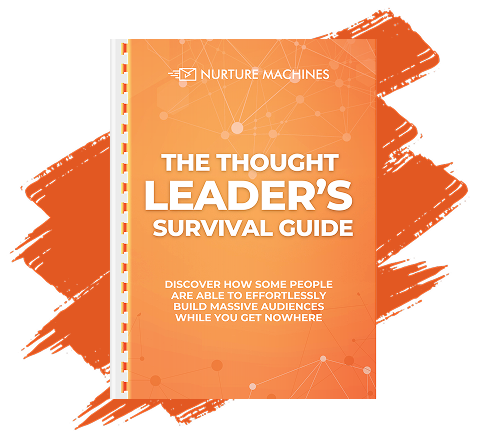Crafting the right message at the right time is no longer optional—it’s the backbone of successful customer engagement. With increasingly diverse audiences and fragmented digital landscapes, businesses must adopt smarter communication strategies. Segmentation, personalization, and journey mapping have become essential tools to connect meaningfully with each customer.
In 2025, brands that understand how to blend data with empathy will stand out. Nurture Machine helps companies achieve this by offering advanced personalization and automation solutions tailored to the modern buyer journey. This blog explores how to create targeted messaging that fuels acquisition, trust, and long-term growth.
Key Takeaways
- Segmentation allows businesses to tailor messaging based on customer demographics, behaviors, and psychographics.
- AI-powered personalization tools from Nurture Machine help deliver timely, relevant messages across channels.
- Customer journey mapping enhances engagement by aligning messaging with each phase of the buyer’s experience.
- Effective cross-channel orchestration builds consistency and improves overall customer satisfaction.
- Tracking key metrics like engagement and conversion rates is essential for refining messaging strategies..
What Are the Key Customer Demographics to Understand for Effective Messaging?

Understanding customer demographics is essential for creating messaging strategies that connect on a personal level. The first step is to analyze factors such as age, gender, income, education, and marital status, as these basic demographics often shape what customers value. Companies use customer data analytics to segment these groups and craft messages that reflect each segment’s unique needs and preferences. For instance, targeting young professionals may involve highlighting convenience and innovation, whereas messages for retirees might focus on reliability, comfort, and ease of use.
How Do Generational Differences Impact Customer Messaging?
Generational differences significantly influence consumer behavior and preferences. Each generation—Baby Boomers, Gen X, Millennials, and Gen Z—has distinct attitudes shaped by historical, economic, and technological contexts. For example, Millennials and Gen Z value authenticity and social responsibility and expect personalized digital experiences, while Baby Boomers might prefer traditional methods of communication with more formal language. Recognizing these differences allows marketers to tailor their tone, imagery, and content to align with the lifestyle and values of each group. Using generational insights, a message can be crafted that speaks directly to the experiences of each age cohort, ensuring relevance and resonance.
Why Is Geographic Segmentation Important in Customer Messaging?
Geographic segmentation involves tailoring messages based on customers’ locations, which can influence cultural norms, climate, language, and regional trends. For example, a marketing campaign targeting customers in the Northeast United States might emphasize winter-related products, whereas a campaign for Southern regions may focus on summer lifestyles. Geography also affects access to services, regional tastes, and even legal considerations. By leveraging geographic data, businesses can ensure that their messaging is not only culturally appropriate but also optimized for local market conditions. This approach increases relevance and helps businesses position their content in a way that resonates with the local audience, leading to higher engagement rates.
How Do Psychographic Factors Influence Messaging Strategies?
Psychographic factors explore the attitudes, interests, lifestyles, and values of customers. Unlike demographic segments that focus on quantifiable metrics, psychographics provide a deeper understanding of what drives consumer behavior and purchasing decisions. For instance, knowing that a segment values sustainability and ethical production enables marketers to highlight eco-friendly attributes of a product. Emotional connection is often formed through storytelling that aligns with customers’ personal identities and aspirations. By incorporating psychographic insights into messaging strategies, companies can create campaigns that speak to customers on a personal and emotional level, ultimately driving engagement and conversion.
What Role Does Behavioral Segmentation Play in Personalizing Messages?
Behavioral segmentation focuses on how customers interact with products, services, and brands. This can include factors such as purchasing behavior, frequency of engagement, brand loyalty, and past interactions. By analyzing patterns like repeat purchases or website activity, businesses can design personalized messages that nurture customer relationships at every touchpoint. For example, a customer who frequently visits a website without making a purchase may benefit from targeted offers or content designed to overcome purchasing hesitations. Nurture Machine supports this through automated behavioral targeting, allowing businesses to time their communications more effectively and maximize the chances of conversion.
How Can You Use Personalization to Connect With Diverse Customer Groups?

Personalization has become a crucial element in effective customer messaging. By incorporating data-driven insights into the messaging process, businesses can create tailored experiences for each customer segment. Personalization means much more than using a customer’s name in an email; it encompasses understanding customer behavior, preferences, and past interactions to predict future needs. Companies leverage advanced segmentation techniques to deliver dynamic content that adjusts in real-time. This approach dramatically increases engagement, as customers are more likely to trust and respond to messages that reflect their personal interests and needs.
What Is Data-Driven Personalization and How Does It Improve Messaging?
Data-driven personalization uses customer data—such as purchase history, browsing behavior, and feedback—to craft highly specific messages. By analyzing quantitative and qualitative data, companies can predict what a customer might be interested in at a given moment and tailor the messaging to meet that expectation. For example, an online retailer may use past purchase data to recommend complementary products or provide exclusive discounts on items the customer is likely to explore. This personalization not only improves the overall customer experience but also increases the likelihood of repeat business. Data-driven personalization utilizes machine learning algorithms and predictive analytics to continuously refine messaging strategies, ensuring continuous improvement in response rates and customer satisfaction.
How Does AI-Powered Personalization Enhance Customer Engagement?
Artificial intelligence is revolutionizing personalized messaging by processing vast amounts of data to predict and influence customer behavior. AI-powered tools can analyze customer interactions across multiple channels to determine the optimal time and format for sending messages. Using natural language processing, these systems craft personalized messages that reflect the unique tone and preferences of each customer segment. For instance, an AI system can note that a particular segment responds better to visual content and then prioritize image-rich emails. Nurture Machine’s AI-powered personalization tools streamline this process, ensuring that each message is highly relevant, timely, and engaging across multiple touchpoints.
How Can Dynamic Content Be Used to Tailor Messages by Segment?
Dynamic content refers to messages that automatically adjust based on the customer’s data profile. This technology allows marketers to create a single template that can display varied content to different segments, such as special promotions, tailored product recommendations, or personalized messages based on previous interactions. For example, a company could design an email that showcases different products depending on the recipient’s past purchases or browsing behavior. Dynamic content ensures that every customer experiences messaging that feels custom-made and relevant, boosting engagement and improving the conversion rate across multiple segments.
What Are Best Practices for Personalization Across Multiple Channels?
To effectively implement personalization across various channels, marketers should follow certain best practices. First, maintain a consistent brand voice that resonates with all customer segments regardless of the medium used. Second, use a unified data platform that integrates customer insights from all points of interaction, from email to social media to in-app notifications. Third, continuously test and refine messages using A/B testing to determine which approaches work best for each segment. Finally, respect customer privacy by ensuring that data is used ethically and securely. These practices help create fluid, personalized experiences that build lasting relationships and drive customer loyalty.
What Are the Best Messaging Strategies for Different Demographic Groups?

Different demographic groups respond differently to messaging strategies, and understanding these nuances is pivotal for effective communication. Tailoring messages involves not only choosing the right content but also presenting it in a tone and format that resonates with the target audience. For example, millennials and Gen Z often value authenticity, simplicity, and immediacy, preferring digital channels such as social media and mobile apps. In contrast, older generations might respond better to more traditional communication methods that emphasize trust, reliability, and clear benefits.
How Do You Craft Compelling Messages for Millennials and Gen Z?
Crafting messages for younger demographics requires an emphasis on visual appeal, authenticity, and social responsibility. Millennials and Gen Z are highly attuned to social issues and are likely to support brands that demonstrate ethical practices and sustainability. The messaging should be straightforward, conversational, and delivered through digital-first channels that these groups frequent, such as Instagram, TikTok, and YouTube. Using engaging storytelling techniques that incorporate humor, real-life experiences, and user-generated content can further enhance the connection with these groups. Moreover, clear calls-to-action that align with their values—such as supporting a cause or experiencing a product with social impact—can drive higher engagement and conversion.
What Tone of Voice Resonates With Various Customer Segments?
The tone of voice in messaging should reflect the personality and values of the target customer segment. For instance, a casual, friendly tone may appeal to younger audiences, while a more formal, authoritative tone might be better suited for professionals or older demographics. Research indicates that tone consistency plays a significant role in building brand trust. Marketers should conduct audience testing to determine which tone yields better results for different segments. A successful tone is one that is authentic, relates directly to the customer’s experience, and evokes the desired emotional response—whether that be excitement, trust, or reassurance.
How Can a/B Testing Optimize Messaging for Diverse Audiences?
A/B testing allows marketers to compare different versions of messages to determine what resonates best with each demographic group. By testing variables such as language, images, call-to-action placement, and overall tone, businesses can refine their messages based on objective performance metrics like click-through rates and conversions. A/B testing helps identify subtle differences in consumer behavior and preferences, enabling marketers to optimize messaging strategies for improved engagement and a higher return on investment. It’s an iterative process that continually adapts to evolving consumer demands and market trends.
How Do Compliance and Privacy Affect Messaging Strategies?
Compliance and privacy are critical considerations in customer messaging. With regulations like GDPR, CCPA, and others in place, companies must ensure that their messaging practices do not compromise customer data. Transparency in data collection and usage builds trust and helps prevent privacy breaches. Messaging strategies must include clear opt-in processes and provide options for customers to manage their preferences. By combining robust data security measures with ethical data collection practices, companies can maintain loyal customer relationships while ensuring that every message is compliant with the latest legal standards.
How Do You Map Customer Journeys to Improve Messaging Effectiveness?

Mapping the customer journey is essential for understanding how customers interact with a brand over time. This process involves identifying key touchpoints—from initial awareness and consideration to purchase and post-sale follow-up—and tailoring messages for each stage. A detailed customer journey map ensures that every interaction is optimized to meet the customer’s needs, thus improving overall engagement. By integrating segmentation data with behavioral insights, businesses can deliver not only personalized but also timely communications that nurture leads through every phase of the customer lifecycle.
What Is Customer Journey Mapping and Why Is It Important?
Customer journey mapping is a strategic process that visualizes every stage a customer goes through when interacting with a brand. It’s important because it identifies gaps and opportunities in the customer experience, enabling marketers to refine their strategies. A well-crafted map highlights critical moments where personalized messaging can influence the customer’s decision-making process, resulting in increased satisfaction and loyalty. By understanding the customer journey, businesses can allocate resources more effectively and ensure that every interaction contributes to a seamless, engaging experience.
How Can Segmentation Inform Customer Journey Stages?
Segmentation plays a vital role in refining the customer journey by categorizing customers based on their unique behaviors and interactions. This allows marketers to identify which segments are more likely to convert at specific stages. For example, high-engagement segments might benefit from detailed product information during the consideration stage, whereas first-time visitors might require introductory content and incentives to encourage trial. By aligning segmentation strategies with the customer journey, businesses can create trigger-based messaging that anticipates customer needs, ultimately leading to more effective lead nurturing and higher conversion rates.
How Does Cross-Channel Orchestration Enhance Customer Experience?
Cross-channel orchestration refers to delivering coordinated messaging across various communication channels—such as email, SMS, social media, and in-app notifications—that together form a cohesive customer experience. This strategy ensures that a customer receives a consistent message regardless of where they interact with the brand. By harmonizing content across channels, businesses can reinforce key messages, build brand coherence, and keep the customer engaged at every touchpoint. The advantage of this approach is that it allows brands to meet customers where they are most active and receptive, thereby optimizing the overall customer journey.
What Metrics Should You Track to Measure Messaging Success?
To gauge the effectiveness of customer messaging, several key performance indicators (KPIs) must be monitored. These include open rates, click-through rates, conversion rates, engagement scores, and customer satisfaction levels. Measuring these metrics provides insights into how well the messages are resonating with the audience and helps marketers identify areas for improvement. Advanced analytics platforms that track customer behavior across multiple channels can offer granular data, allowing for continuous optimization of messaging strategies. By regularly reviewing these metrics, companies can fine-tune their approaches to ensure that every touchpoint drives value.
Frequently Asked Questions
What is the importance of segmentation in customer messaging?
Segmentation helps brands tailor messages to specific customer needs, behaviors, and preferences. By dividing audiences into targeted groups, businesses send more relevant content, which boosts engagement and conversion rates. Nurture Machine supports advanced segmentation to deliver precise, personalized messaging across channels.
How can AI improve personalized customer communication?
AI analyzes customer behavior and preferences to craft dynamic, personalized messages in real time. It automates timing, tone, and content for each user, increasing relevance and responsiveness. Nurture Machine’s AI tools enable smarter campaigns that adapt to each customer journey.
What role does customer journey mapping play in messaging effectiveness?
Mapping the customer journey highlights key touchpoints and pain points. It ensures messages are delivered at the right time and with the right context, increasing impact. Nurture Machine uses journey mapping to align communication with customer expectations at every stage.
How do language and cultural differences affect messaging strategies?
Language and cultural context shape how messages are received and interpreted. Misalignment can lead to confusion or disengagement. Tailoring tone, content, and visuals to specific audiences enhances trust and performance. Nurture Machine allows for localized messaging to support global or diverse campaigns.
What metrics should be tracked to measure the success of customer messaging campaigns?
Key metrics include open rates, click-through rates, conversion rates, engagement scores, and unsubscribe rates. These indicators show message relevance, timing effectiveness, and overall campaign health. Nurture Machine’s dashboard helps monitor and optimize these metrics in real time for better performance.
Conclusion
In a world where customers expect highly personalized interactions, a generic message no longer drives results. Understanding demographics, behaviors, and emotional triggers empowers businesses to craft communications that truly resonate. Nurture Machine supports this effort with tools that simplify segmentation, automate personalization, and guide messaging across the customer journey.
From dynamic content to cross-channel alignment, their platform helps you speak to customers with precision and purpose. The result? Stronger engagement, lower acquisition costs, and improved ROI. With the right strategy and support, your messaging can turn casual visitors into loyal advocates.






